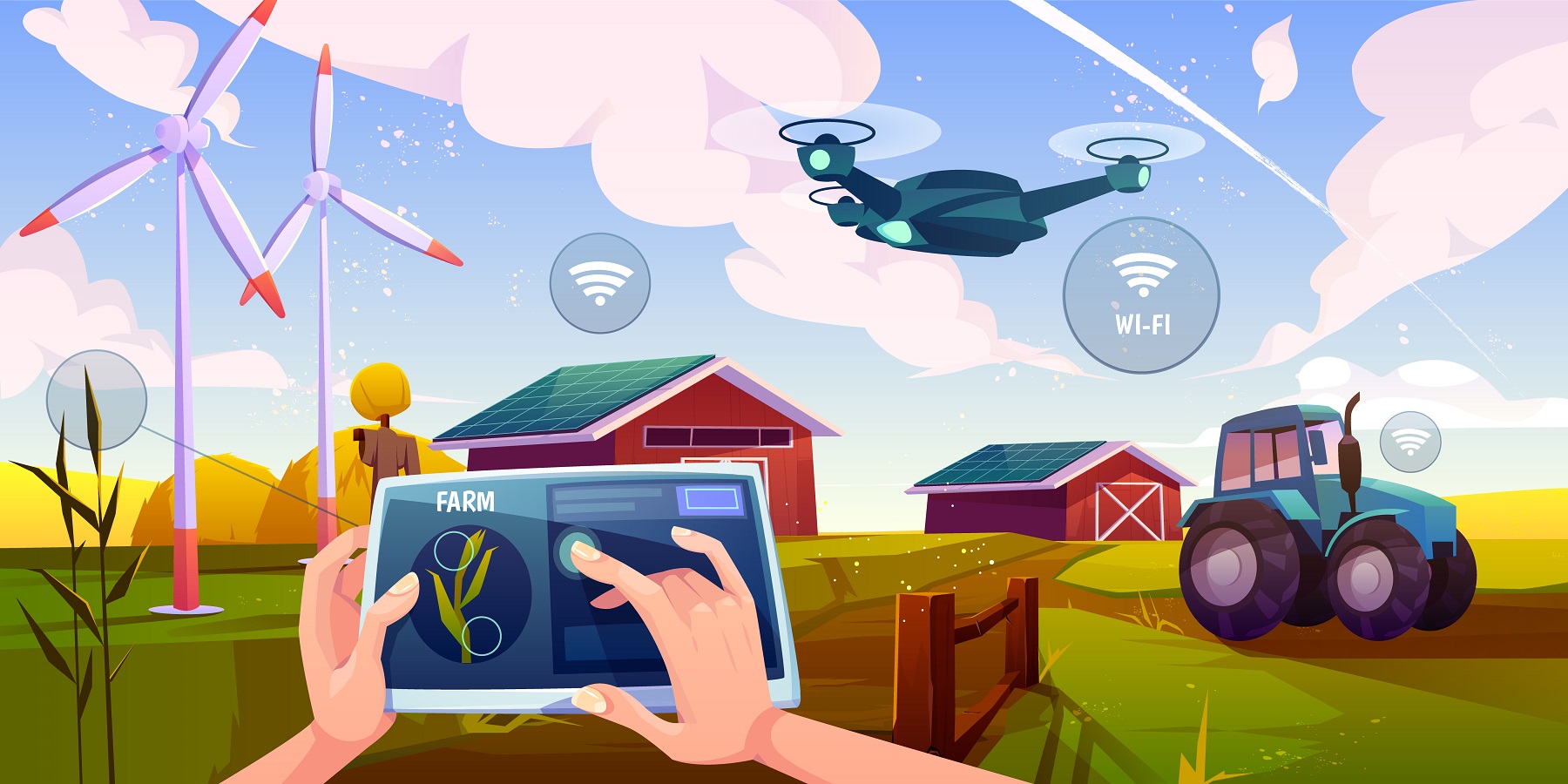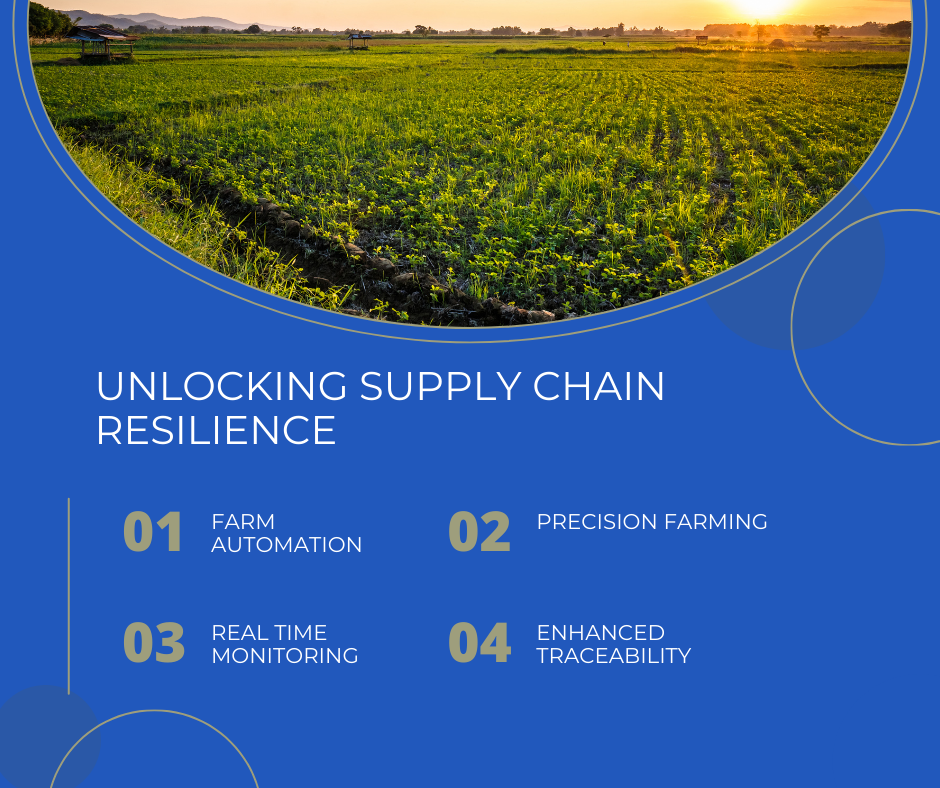Contact: +91 99725 24322 |
Menu
Menu
Quick summary: Explore the intricate dynamics of agriculture and food supply chain disruption in this insightful blog. Uncover the pivotal factors shaping the industry's resilience and learn how stakeholders can navigate challenges for enhanced sustainability and food security.

In the landscape of agriculture and food supply chains, disruptions can arise from various factors, impacting production, distribution, and consumption patterns worldwide. Understanding these factors is crucial for stakeholders across the supply chain to anticipate, mitigate, and adapt to potential disruptions effectively.
According to World Bank, do you know that agriculture is the primary source of livelihood for 58% of India’s population?
India is the world’s second largest producer of food after China, according to the Ministry of Agriculture and Farmer’s welfare and is the largest producer of several agriculture commodities including milk, spices, pulses and jute.
The agriculture sector contributes to 17 to 18% to India’s GDP and according to McKinsey has the potential to grow from current value of 370USD to 500USD by 2025.
The global smart agriculture market in 2018 was approximately USD 6455 million which is expected to grow at a CAGR of 13.09% to reach USD 19625 million by 2027. The world population is expected to reach 10 billion by 2050. Crop production and farming activities need to increase to meet the demands of the growing population. Agriculture companies need to increase their presence in meeting these demands. The Asia Pacific was the largest region in the agriculture market followed by North America in 2021. The agriculture market is segmented into crop production, animal produce, and other rural activities.
However the agriculture supply chain in India faces several challenges like fragmentation of land holdings, lack of access to technology and credit, inefficient marketing and distribution and lack of infrastructure.
India has the highest net-cropped area and a fast-growing population which makes it difficult to balance. It is said that India’s population is growing faster than the rate at which India is currently producing. Even though we have the largest net crop and agriculture contributes majorly to the GDP, India’s agriculture has the potential to influence the world market.
Various farming and its ancillary factors affect the slow growth of agriculture in India.
For such a colossal industry to work in tandem, the need for a proper supply chain and its efficient management becomes important. The supply chain refers to every such activity that the product makes its journey, from the sourcing of raw materials to the finished product reaching the final consumer. Briefly, it includes agricultural input, production, processing, marketing, transportation, and distribution. Supply chain management helps in handling the entire supply chain for smooth functioning of all processes with maximum efficiency and quality to provide effective results and to maximize profits.
The structure of a supply chain differs from one product to another, it takes into account many factors like organizational behavior, product characteristics, shelf life, marketing, number of players, etc while formulating a supply chain model. The recent Indian agriculture market is forced to make certain changes resulting in globalization and increased risks. The Indian Government has been strategically developing models and policies like Pradhan Mantri Krishi Sinchai Yojana, Paramparagat Krishi Vikas Yojana (PKVY), and National Agriculture Market (eNAM), National Mission for Sustainable Agriculture (NMSA), aiding various supply chains and agriculture as a whole.Global supply chain
Food and agribusiness form a $5 trillion global industry that has been only getting bigger.
Food wastage around the world is no different, one-third of the global food is wasted throughout the year and 40% of it occurs in the production and processing stage.
The global production systems have crossed many borders. The wheat produced in Ukraine is processed as flour in Indonesia and is exported to make bread in Africa. These global value chains connect food producers to consumers across the world.
When a supply chain transitions from local or regional operations to a global scale, several significant changes occur:

Automation of farm operations refers to the integration of technology and machinery to perform tasks traditionally carried out by humans manually. This includes a wide range of activities across the agricultural value chain, from planting and irrigation to harvesting and post-harvest processing.
One aspect of automation involves the use of robotics and machinery equipped with sensors, cameras, and GPS technology to perform precise tasks such as planting seeds, applying fertilizers and pesticides, and harvesting crops. These automated systems can operate autonomously or be controlled remotely by farmers using computers or mobile devices, allowing for increased efficiency and accuracy in farm operations. Additionally, automation extends to data collection and analysis through the use of sensors and IoT (Internet of Things) devices installed throughout the farm. These devices collect real-time data on soil moisture, weather conditions, crop health, and equipment performance, which is then analyzed using algorithms and AI (Artificial Intelligence) to make data-driven decisions.
Advantages
Learn how cutting-edge technologies are revolutionizing agricultural practices and maximizing yields.
Dive into the world of precision agriculture and discover how crop monitoring is shaping the future of food production.
Transparency in supply chain traceability due to farm digitization refers to the increased visibility and accountability achieved through the adoption of digital technologies in agricultural operations. As farms embrace digital tools and platforms, they generate vast amounts of data related to crop cultivation, harvesting, and processing. This data, collected through sensors, drones, GPS trackers, and other IoT devices, provides detailed insights into various aspects of farm management, including soil health, weather conditions, crop growth, and resource usage.
By digitizing farm operations, farmers can accurately track the journey of their products from the field to the consumer, ensuring transparency at every stage of the supply chain. For example, farmers can use digital platforms to record planting dates, application of fertilizers and pesticides, and harvest yields. This information can then be securely stored and shared with downstream stakeholders such as processors, distributors, and retailers. Furthermore, farm digitization enables the implementation of traceability systems that allow for the identification and tracking of individual products throughout the supply chain. Each product can be assigned a unique digital identifier, such as a QR code or RFID tag, which contains information about its origin, production methods, and handling practices. This level of traceability helps to prevent fraud, ensure food safety, and meet regulatory requirements.
Advantages
Providing reliable information from crop field to production at every touchpoint involves ensuring the accuracy and consistency of data throughout the agricultural supply chain. This process begins at the crop field, where data is collected on various aspects of cultivation, including planting, irrigation, fertilization, and pest management. Farmers use digital tools such as sensors, drones, and farm management software to capture this information in real-time.
Explore the key objectives of farm management and discover strategies for optimizing agricultural operations.
Unlock the secrets to successful farm management!
As the crops progress through the production process, from harvesting to processing and packaging, it’s essential to maintain the integrity of the data and ensure that it remains reliable at every touch point. This involves tracking the movement of crops, recording any changes or interventions made during processing, and documenting quality control measures. By providing reliable information at every stage, stakeholders along the supply chain can make informed decisions about sourcing, production planning, inventory management, and distribution. This transparency also enhances trust between producers, suppliers, manufacturers, and consumers, as everyone has access to accurate data about the products’ origin, quality, and safety.
Advantages
TraceX blockchain-powered traceability and farm management solutions play a crucial role in providing reliable information from crop field to production at every touchpoint. By leveraging blockchain technology, TraceX ensures the immutability and transparency of data, enhancing trust and integrity throughout the agricultural supply chain.
At the crop field level, it enables farmers to digitize their operations, capturing real-time data on planting, cultivation practices, and environmental conditions. This data is securely recorded on the blockchain, providing an auditable trail of the crop’s journey from seed to harvest. As the crops progress through the production process, the platform facilitates seamless traceability, allowing stakeholders to track the movement and transformation of products at each stage. With blockchain-powered traceability, users can access detailed information about the origin, quality, and safety of the products, ensuring compliance with regulatory standards and consumer expectations.
Moreover, TraceX farm management solutions streamline operations, optimizing resource allocation, and enhancing productivity. By integrating farm management functionalities with blockchain traceability, it ensures that reliable information is captured and shared across the supply chain, enabling stakeholders to make informed decisions and respond effectively to challenges.
Overall, TraceX blockchain-powered solutions help to foster transparency, trust, and efficiency in the agricultural supply chain, ultimately contributing to a more sustainable and resilient food system.
In conclusion, understanding the key factors that influence agriculture and food supply chain disruption is paramount for stakeholders across the industry. As highlighted throughout this blog, factors such as climate change, technological advancements, and geopolitical events significantly impact the stability and resilience of the food supply chain. By recognizing these factors and implementing proactive measures to mitigate risks, stakeholders can better prepare for and navigate disruptions, ensuring the continued availability and accessibility of food resources. Moreover, fostering collaboration, innovation, and sustainability initiatives will be essential for building a more resilient and adaptive food supply chain capable of addressing future challenges and uncertainties. As we move forward, it is imperative for stakeholders to remain vigilant, adaptive, and collaborative in their efforts to strengthen the resilience of the agriculture and food supply chain for the benefit of global food security and sustainability.
